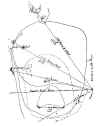|

 Up
Up

 Two for the
Two for the
History Books

(You are here.)



  Need
to Need
to
find your
bearings?
Try
these
navigation aids:
If
this is your first
visit, please stop by:
Something
to share?
Please:



|
|
Available in Française, Español, Português, Deutsch, Россию,
中文,
日本, and others.
 top
a minute to consider what was about to take place. In this day and age, we fly so often
that we hardly think of it as exciting or dangerous. But what Charley was about to do was
every bit as risky and rewarding as the first two-man space shots — the Voshkod and
Gemini programs — of the early 1960s. In fact, given the circumstances, it was
considerably more dangerous. Neither one of the pilots had the luxury of practicing on a
simulator, as the early astronauts did. Orville and Wilbur had accumulated less than an
hour's experience — combined — with the new control system on the Flyer.
The motor was equally as untried, and had never before been used for a flight lasting more
than a few minutes. If there was a major accident, the nearest professional medical help
was in Elizabeth City, almost a day's travel by boat. top
a minute to consider what was about to take place. In this day and age, we fly so often
that we hardly think of it as exciting or dangerous. But what Charley was about to do was
every bit as risky and rewarding as the first two-man space shots — the Voshkod and
Gemini programs — of the early 1960s. In fact, given the circumstances, it was
considerably more dangerous. Neither one of the pilots had the luxury of practicing on a
simulator, as the early astronauts did. Orville and Wilbur had accumulated less than an
hour's experience — combined — with the new control system on the Flyer.
The motor was equally as untried, and had never before been used for a flight lasting more
than a few minutes. If there was a major accident, the nearest professional medical help
was in Elizabeth City, almost a day's travel by boat. Also remember that Charley wasn't
just a simple passenger, a living, breathing bag of sand. Will and Orv chose Charley for
good reason. They needed his mechanical skills. The short flights made between May 6 and
May 14 suggested that the engine might overheat if it was allowed to run a long time with
two people aboard, and it needed to be monitored. The Wrights would operate the airplane;
Charley would operate the engine. Charley was asked to become the first flight engineer.
Charley climbed into the right seat. Wilbur took the controls next to him. According to
Wilbur's diary, the first flight of the day got off to a good start. They had flown about
800 feet and had been in the air less than half a minute when Wilbur made a mistake with
the controls, nosing the plane over. He recovered in time to set it down gently, and the
three hauled it back to the launching rail.
The next flight convinced the team that they had a true two-man aircraft. Here's how
Wilbur described it:
"Orville and Chas. tried a flight together and after one false start, sailed away
nicely. They passed around the West Hill, came north alongside the Little Hill by the
sound, and back by way of the starting point. When about half way round the West Hill on
the second lap, the heating of the engine bearing compelled them to land."
Wilbur and Charley later paced off the flight to determine exactly how far he and
Orville had traveled. They estimated the flight covered 4506 yards (about 2-1/8 miles),
traveling at a ground speed of about 33 miles per hour. They were in the air for 4 minutes
and 2 seconds, and reached an altitude of about 30 feet.
Before lunch, Wilbur tried three more times to get off the ground with Charley aboard,
but the wind had shifted and the plane had trouble taking off in a crosswind. The upwind
wing tip kept digging into the sand — he still hadn't got the hang of the controls.
Will, Orv, and Charley repositioned the launching rail in the afternoon and Will decided
to take off alone to gain more practice with the control system. He made a seven-minute
flight, and found that the engine still overheated at the beginning of the flight, but
cooled down immediately when the oil pump had been working for a few minutes —
Orville and Charley might have kept flying if they had known. Then a gust a wind hit him
and began to roll the plane to one side. Will attempted to roll it back and moved the
wrong lever, diving the Flyer 3 into a sand dune at 40 miles per hour. He was not badly
hurt, but the plane was beyond easy repair. If they had time, the three probably could
have put it back to rights in a week. But there was pressing business in France, the
Signal Corps wanted their aircraft, and time was getting short. Orv, Will, and Charley
dragged the Flyer's remains a mile and a half on a hastily made sledge and stored it in
the hangar, where it rested for years. |

Wilbur sketched this map of Orville and Charley's flight together. |